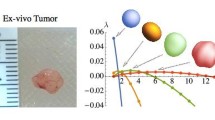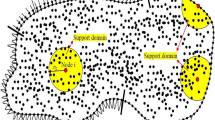Abstract.
In this paper we examine spatio-temporal pattern formation in reaction-diffusion systems on the surface of the unit sphere in 3D. We first generalise the usual linear stability analysis for a two-chemical system to this geometrical context. Noting the limitations of this approach (in terms of rigorous prediction of spatially heterogeneous steady-states) leads us to develop, as an alternative, a novel numerical method which can be applied to systems of any dimension with any reaction kinetics. This numerical method is based on the method of lines with spherical harmonics and uses fast Fourier transforms to expedite the computation of the reaction kinetics. Numerical experiments show that this method efficiently computes the evolution of spatial patterns and yields numerical results which coincide with those predicted by linear stability analysis when the latter is known. Using these tools, we then investigate the rôle that pre-pattern (Turing) theory may play in the growth and development of solid tumours. The theoretical steady-state distributions of two chemicals (one a growth activating factor, the other a growth inhibitory factor) are compared with the experimentally and clinically observed spatial heterogeneity of cancer cells in small, solid spherical tumours such as multicell spheroids and carcinomas. Moreover, we suggest a number of chemicals which are known to be produced by tumour cells (autocrine growth factors), and are also known to interact with one another, as possible growth promoting and growth inhibiting factors respectively. In order to connect more concretely the numerical method to this application, we compute spatially heterogeneous patterns on the surface of a growing spherical tumour, modelled as a moving-boundary problem. The numerical results strongly support the theoretical expectations in this case. Finally in an appendix we give a brief analysis of the numerical method.
Similar content being viewed by others
Author information
Authors and Affiliations
Additional information
Received: 27 July 2000 / Revised version: 15 August 2000 / Published online: 16 February 2001
Rights and permissions
About this article
Cite this article
Chaplain, M., Ganesh, M. & Graham, I. Spatio-temporal pattern formation on spherical surfaces: numerical simulation and application to solid tumour growth. J Math Biol 42, 387–423 (2001). https://doi.org/10.1007/s002850000067
Issue Date:
DOI: https://doi.org/10.1007/s002850000067




